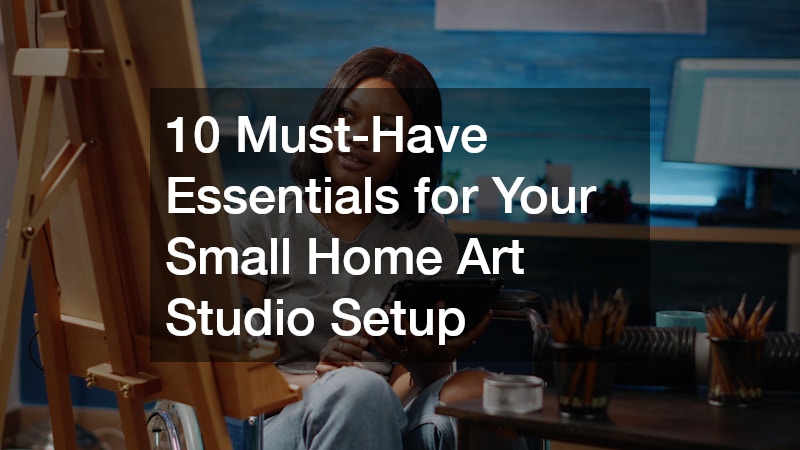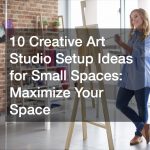
Creating a functional and inspiring home art studio is a dream for many artists, whether you’re a hobbyist or a seasoned creator. Even with limited space, you can design a compact yet productive art environment that sparks creativity and supports your artistic goals.
In this article, we’ll walk you through the 10 must-have essentials for your small home art studio setup, with practical tips for maximizing space, minimizing clutter, and crafting a workspace that truly works for you.
Let’s dive in and explore how to turn your cozy corner into a powerhouse of creativity.
1. A Dedicated Workspace: Where Will Your Creativity Happen?
Before you buy any supplies or furniture, you need to decide where your home art studio will be. Even the smallest of spaces—a corner of a room, an unused closet, or a section of the garage—can be transformed into an artistic haven with a little ingenuity.
Tips for choosing your space:
- Natural light: If possible, pick a spot near a window. Good lighting reduces eye strain and enhances color accuracy.
- Ventilation: Especially important if you’re working with oil paints, varnish, or aerosols.
- Noise level: Try to choose a quiet space where you can focus.
Your dedicated workspace doesn’t have to be big. What matters is that it’s yours, and you feel comfortable and free to create there.
2. Sturdy Work Surface: What Table Works Best?
A reliable, solid surface is crucial for any art studio setup. Your table or desk should accommodate your primary medium and give you enough elbow room to move freely while working.
Consider these table options:
- Adjustable drafting tables for versatility and comfort
- Folding tables for temporary setups
- Repurposed desks for an eco-friendly and budget-conscious choice
For a small home art studio, a foldable or wall-mounted table can save space while still being functional. Don’t forget to protect your surface with a cutting mat or heavy-duty drop cloth.
3. Storage Solutions: How Can You Stay Organized?
Clutter is the enemy of creativity. In a small space, having an organized storage system is essential. You want your materials to be easily accessible but neatly contained.
Smart storage ideas:
- Rolling carts with drawers for paint, brushes, and tools
- Pegboards to hang tools and keep the tabletop clear
- Clear bins or jars for visibility and quick access
- Vertical shelving to use the wall space efficiently
Label everything and develop a system that fits your workflow. The less time you spend searching for materials, the more time you’ll have to create.
4. Proper Lighting: Are You Seeing Colors Correctly?
Lighting can make or break your artistic process. While natural light is ideal, it’s not always available—especially if you’re working at night or in a windowless room.
Lighting essentials:
- Daylight LED bulbs for consistent, color-accurate lighting
- Adjustable task lamps to direct light where you need it
- Clip-on lights for flexibility in tight spaces
Avoid yellow-tinted or fluorescent lighting that distorts color perception. Proper lighting ensures you’re seeing your work as it truly is.
5. Comfortable Seating: Why Does Ergonomics Matter?
Long hours of drawing, painting, or sculpting can take a toll on your body. Investing in ergonomic seating will support your posture, reduce fatigue, and keep you focused on creating.
What to look for:
- Adjustable height to match your table
- Back support to avoid strain during long sessions
- Easy mobility to maneuver within your studio
A stool with a footrest or a rolling office chair is a popular choice among artists working in compact studios. Remember, your comfort is crucial to your productivity.
6. Tools of the Trade: What Should Every Artist Have?
Your tool selection depends on your medium, but some items are universal across artistic disciplines. Stock your studio with essential tools that you use regularly.
Basic toolkit for most artists:
- A variety of paintbrushes or drawing pens
- Cutting tools like X-Acto knives or scissors
- Rulers, T-squares, and compasses
- Palettes or mixing trays
- Cleaning supplies for tools and the workspace
Don’t overstock. Keep only what you use often, and rotate in specialized tools as needed for projects.
7. Art Supplies: How to Store Them Efficiently?
Your supplies should be easy to find, but not taking over your workspace. Group items by type—such as paints, markers, and pastels—and store them in labeled containers or trays.
Best practices for managing art supplies:
- Keep daily-use supplies on your work surface or top drawers
- Use drawer dividers for pencils, brushes, and pens
- Hang tubes or palettes on hooks to save space
- Group paints by color family for faster mixing
Always seal containers to preserve materials and prevent spills or dry-out. Inventory your supplies occasionally so you can restock before running out.
8. Inspiration Board: What Keeps You Motivated?
Creativity thrives when it’s nurtured. An inspiration or mood board helps you stay visually connected to your ideas, goals, and ongoing projects.
What to include:
- Photos, clippings, and swatches
- Quotes and affirmations
- Mini versions of your artwork
- Project deadlines or goals
You can use corkboards, magnetic boards, or even a simple string and clip setup on the wall. The key is to keep it visible and updated.
9. Easy-to-Clean Flooring: Why Should You Protect Your Floors?
Even the most careful artists deal with spills. In a small home art studio, your flooring choice can help with maintenance and longevity.
Floor protection options:
- Plastic floor mats under your chair and table
- Old rugs or drop cloths to catch paint or debris
- Peel-and-stick tiles for a washable and damage-resistant surface
If you’re renting or sharing the space with others, protecting the floor is non-negotiable. It’s also one less thing to worry about when you’re deep into a project.
10. Personal Touches: How Can You Make the Space Yours?
Lastly, don’t forget the personal touches that make your studio feel special. This is your sanctuary—your little pocket of the world where imagination lives.
Personalize with:
- Favorite colors or textures in decor
- Artwork from other artists for inspiration
- Plants or aromatherapy to create a calming atmosphere
- Music setup or Bluetooth speaker for ambiance
These small additions foster a deeper connection with your workspace, helping you feel relaxed, happy, and ready to create.
How to Keep Your Studio Safe and Mess-Free
Safety often takes a backseat in home studio setups, but it’s a non-negotiable, especially in small spaces. From hazardous chemicals like turpentine or fixatives to sharp tools and hot appliances like glue guns, even simple art materials can pose risks if not managed well.
Safety and cleanliness tips:
- Store flammable items in a fireproof container
- Keep ventilation adequate when using solvents or spray paints
- Install a small smoke detector or carbon monoxide alarm
- Clean up spills immediately to avoid slipping
- Use a lockable cabinet for sharp or hazardous items
Also, always have a trash can or recycling bin within arm’s reach. The neater your space, the less likely you are to have accidents or lose valuable tools in clutter.
Should You Go Digital? Tablets and Tech Tools for Artists
While traditional art tools are essential, many artists today blend digital tools into their creative process. A small home art studio can benefit from incorporating tech that expands your artistic potential without eating up physical space.
Digital tools worth considering:
- Drawing tablets (like Wacom or iPad Pro) for sketching, painting, and editing
- Ring lights and phone mounts for content creators sharing their process online
- Art software (e.g., Procreate, Adobe Fresco, Krita) for digital painting and concept work
- Cloud storage to back up digital files and artwork
Having a small charging station or tech drawer in your studio can keep wires from tangling and devices from disappearing. With the right tools, your home studio can bridge the best of both traditional and digital worlds.
How to Showcase and Store Finished Artwork
One often overlooked element of any art studio setup is how to handle finished work. In a small space, it’s easy to let completed pieces pile up, risking damage or disorganization. But your artwork deserves to be properly stored or displayed, both for preservation and personal motivation.
Storage and display solutions:
- Use portfolio cases or flat files for drawings and paintings
- Install floating shelves or gallery walls to show off recent work
- Use protective sleeves or glassine paper to prevent smudges and scratches
- Label and date your work, especially if you plan to sell or exhibit it later
Regularly rotating artwork on your walls not only protects stored pieces but also keeps your space visually fresh and inspiring.
Bonus: Tips for Maintaining Your Small Home Art Studio Setup
Once your studio is set up, it’s important to keep it functional and fresh. A cluttered or neglected space can stifle your motivation.
Maintenance checklist:
- Tidy up after every session
- Do a deep clean once a week
- Purge unused supplies every few months
- Rearrange furniture occasionally for a fresh perspective
- Update your inspiration board regularly
Treat your studio like a living extension of your creative process—it evolves as you do.
Final Thoughts: Creating an Artistic Oasis at Home
Your small home art studio setup doesn’t have to be expensive or expansive to be effective. With the right essentials—like a reliable work surface, strategic storage, good lighting, and thoughtful personalization—you can create a studio that fits your space and fuels your passion.
Whether you’re painting on weekends, illustrating every day, or simply want a cozy spot to doodle, these essentials will help you get started. With a little creativity, even the smallest space can become your artistic sanctuary.




